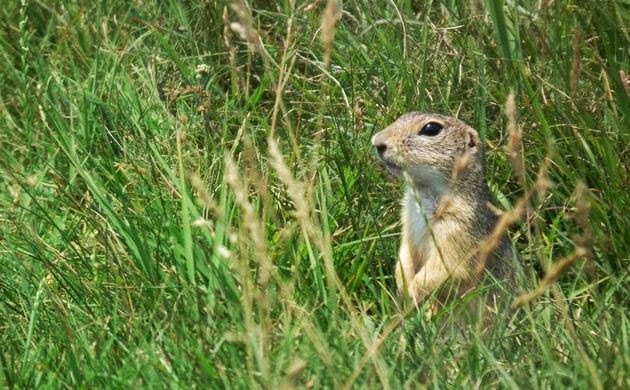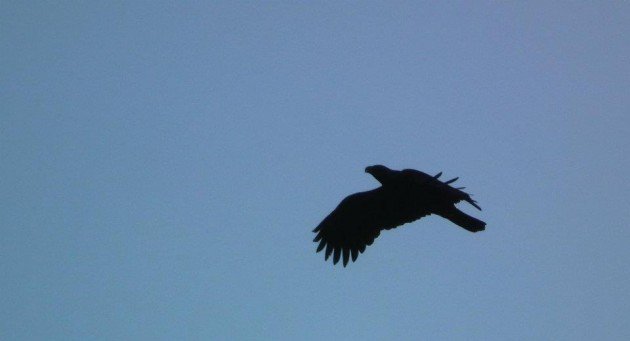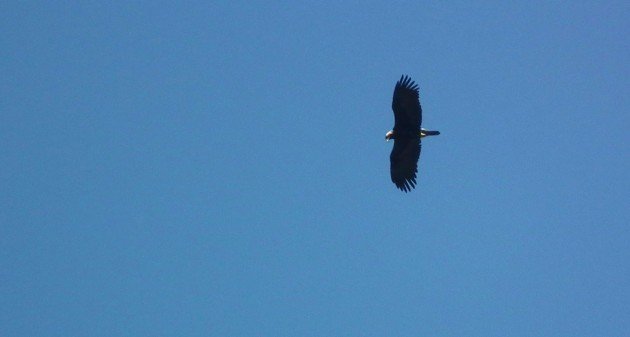
One brightly coloured male Common Redstart is patrolling a nearby hedge, while a pair of Common Ravens is circling the valley. Driving on a sunny May morning through meadows and vineyards takes me to the Mt. Fruska Gora national park. I pass the European Bee-eater colony, echoing with their bubbling voices and African-style colours. Fruska Gora is a low, forested massif – mostly oak, lime, beech, hornbeam and ash – situated in northern Serbia.
The narrow, winding road leads me through arable fields where Common Skylarks are chirruping and whistling while taking steep flights upward and then falling down, when the song stops: they sing only in mid-air. Skylarking (or singing in mid-air) is a local slang for having sex.
Bushes along the road are decorated with European Stonechats. Nearing the village, I reach a pastureland dotted with lovely Sousliks (or European ground squirrels), some of them busy eating, others playfully chasing each other, while third ones are standing on their hind legs and observing the sky – they know why.
And so do I – that is the reason I am here. This is where an Eastern Imperial Eagle comes for breakfast!
In the early 20th century, Imperial Eagles used to live not only in the northern lowlands of Serbia, but also in the southern highland plateaus. Curiously, some eagles were also observed by the Ada Ciganlija Island, within Belgrade – in the breeding season! The biggest number of these birds ever seen at once was nine, in the spring of 1910. But persecution, killing and poisoning in the late 20th century has led to their demise and at the beginning of the new millennium, Serbia had only two to three pairs of Imperial Eagles.
In other words, this globally threatened species barely made it in Serbia. In the same period, neighbouring Hungary had more than 60 pairs of them. Today, Serbia’s population has risen to 4 to 5 pairs, while Hungary’s went up to 130+ pairs! We must be doing something wrong?
These large birds need secluded spots to raise their young, and Serbia seems to be lacking such places. Poaching is still rampant – only last November, a young Imperial Eagle was shot in the Belgrade municipality of Surcin, later operated on, but it succumbed to injuries after the surgery (one of the reasons was lack of proper rehabilitation facility). Try to guess how many birds end up killed and stuffed to collect steam from cooking, dust and moths above the favourite armchair of a proud killer?
The fact that I know that one pair breeds nearby is by no means a guarantee of a sighting and every other time, I go home empty handed… or empty binoculared. I turn my eyes from Sousliks to the sky – and immediately see an eagle circling high above the pastures.
I am trying to get closer along the dirt tracks between the fields, but the bird disappears. A raptor chased by Hooded Crows… my eagle? No, just a Common Buzzard, beautiful bird itself – but not an eagle.
I am taking to high ground to keep an eye on a wider area and, soon, my Imperial Eagle reappears at the same spot I found it the first time. Once there, the eagle soars above my car till my neck hurts… he is ever higher – and then he is gone.















Cool post, would love to go birding in Fruska Gora.
Buzz me when you’re around, Pat. Another specialty breeding nearby is the Black-headed Bunting.
These days I am considering to try ticking White-tailed, Eastern Imperial and Lesser Spotted Eagles in the same wider area in the same day (theoretically possible, but will they all show?), plus three “blacks”: Black Kite, Black Stork and the B-H Bunting.
The rarest bird of that particular area would be the Saker Falcon – that one asks for more luck than the eagles.
@Dragan: Wonderfully written, with a good (if sobering) conservation message. And now I have a better idea of why the band XTC called one of their albums “Skylarking” … I’ll have to dig that out this weekend. 🙂
Thanks, Meredith, but I am not sure skylarking has the same meaning in English. I’ve googled for the meaning (of life?) and even found skylarking = birding
Ah, well that’s simple. If you’re up on your Douglas Adams, you already know that the answer to the ultimate question of life, the universe, and everything is 42. 🙂
What a thought-provoking article. It’s easy to just assume that there is a never ending supply of birds such as these. Thank you Dragan.
Meredith, some three years ago Serbian government has adopted the new Decree on strictly protected and protected species without a prior public consultation. I have asked twice to see the draft versions, but was always informed that they will be available later – they never were available. And so, several nature and birds protection NGOs complained to the Chair of the Parliament and to the Prime Minister requesting annulation of the act (how naive that sounds?). Next action was having the meeting with the Minister’s assistant and at the beginning of the meeting, I was commenting their claim that the drafts were available for 14 days on their website – in mid-August, peak of the holidays season when no one checks Government websites, by saying that the announcement that the Earth was going to be destroyed was available for centuries at municipality that and that at the planet that and that and it can hardly qualify as a public debate – and I’ve meet only blank stares. Professor Doctor that and that and his side cronies had absolutely no clue about the Guide. Of course, as it was to be expected, they have listened, but to no avail, no legal response ever came out of it. Even worse, by meeting them, we foolishly gave their Decree legitimacy – they had the meeting with us, and could call it a public debate (after the Decree become official and not before it….)
Yep, once upon a time it was assumed that the Passenger Pigeons were a never ending supply of cheap meat for the fast-growing cities in the East. Next year it will be exactly 100 years since Martha died. And eagles were always in much shorter supply than pigeons…
@Dragan: Just as great minds think alike, it seems small ones do, too. I hope you’re able to get the government to come around on this issue. And nice work giving it your best Arthur Dent shot.
@Noel: It kinda reminds me of how House Sparrows are a ubiquitous nuisance in the States, but their numbers are on the decline in the U.K.